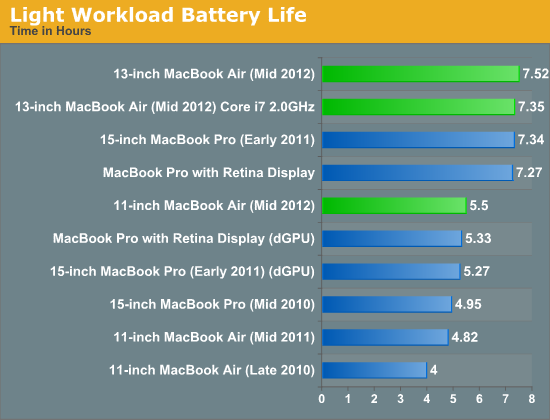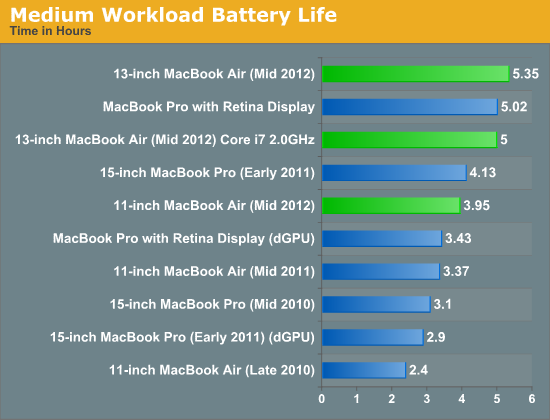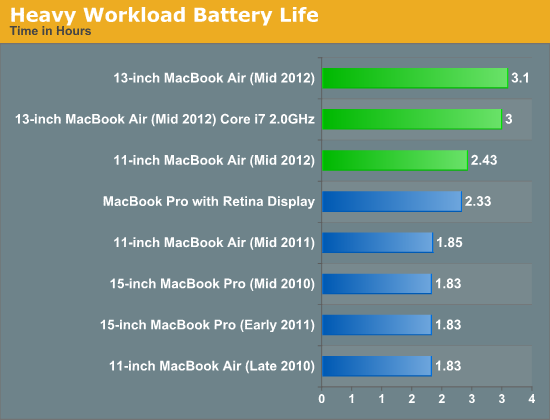The 2012 MacBook Air (11 & 13-inch) Review
by Anand Lal Shimpi on July 16, 2012 12:53 PM EST- Posted in
- Apple
- Mac
- MacBook Air
- Laptops
- Notebooks
Battery Life
The MacBook Air sees no increase in battery capacity over the previous generation, as a result any improvement in battery life boils down to what we get from Ivy Bridge. I'm stuck rebuilding the battery life results database from scratch now that I've built a new suite of tests for OS X. I've run all three generations of 11-inch MacBook Air through the new suite but I don't have numbers for the older 13-inch MBAs unfortunately. As I mentioned in the rMBP review, the new suite is designed to give accurate data points at three usage models: one light, one medium and one heavy. The combination of all three should give you an idea of the behavior of these systems on battery.
Across the board battery life of the 13-inch MacBook Air is actually quite similar to the Retina MacBook Pro, just from a much smaller battery and without the variability introduced by the rMBP's discrete GPU. If anything the lack of a discrete GPU makes using the MacBook Air much simpler from a battery life perspective. As much as I love Cody Krieger's gfxCardStatus application, it's nice not having to keep an eye on it to see if something silly has triggered the dGPU.

Under light usage the new 13-inch MacBook Air is easily able to meet Apple's claim of 7 hours of battery life. The 11-inch model does the same to its 5 hours rating, beating it by the same 30 minute margin as the 13.

The medium workload thins the herd a bit, with the 13-inch Air still coming out on top but at 5.35 hours. The 11-inch Air drops below 4 hours, which is an improvement over the previous two generations of 11-inch Airs. Once again we see an example of Ivy Bridge doing better than Sandy Bridge when it comes to mobile power usage.

Under heavy load is really where we see Intel's 22nm process deliver the gold. Here both of the 2012 MacBook Air models do very well. With the 13-inch MBA significantly outpacing even the rMBP with its 95Wh battery, while doing the exact same amount of work.
The 13-inch MacBook Air continues to be Apple's best notebook for those who care about battery life. The 11 offers portability but you do take a significant hit in battery life.










190 Comments
View All Comments
pmhparis - Wednesday, July 18, 2012 - link
What software is heavily crippled on Macs? Other than CAM/CAD which is very specialized, needs specific harware & is only used by a tiny minority, I cannot think of any.Either be specific or admit that you're full of FUD.
Tegeril - Monday, July 16, 2012 - link
I've seen a lot of discussion on the AT forums and elsewhere, trying to tangibly represent the changes in GPU performance over a number of generations of Mac laptops and desktops, but specifically what you really get out of Intel's new graphics versus the older Nvidia solutions.I'd love to see some kind of reporting on the relative performance of things like:
Intel 2000
Intel 3000
Intel 4000
Nvidia 9400m
Nvidia 320m
----
Nvidia 330m/gt/whatever it was
AMD 6630M
Basically to see how Intel's graphics stack up against the systems that many people are currently using and upon which they are contemplating an upgrade. Perhaps it will be best times for a Haswell comparison so you can throw in Intel 5000 or whatever they decide to call it. But I do think people would find it valuable when considering something like:
"I have this first gen Core i7 CPU MacBook Pro with a 330m/gt in it, if I don't want a retina MBP, my only graphics option without spending $1800 is Intel 4000, how does that stand up to what I'm using now" etc etc.
Anyway, great review as usual, if i weren't already an rMBP owner, I'd be gunning for a 13" MBA.
tipoo - Monday, July 16, 2012 - link
I agree, they should be added to Benchhttp://www.anandtech.com/bench/GPU12/372
Tegeril - Monday, July 16, 2012 - link
I can attest to frequent GPU issues, display corruption, other nonsense with my AMD equipped (6970M) iMac.I'd much rather they keep diversity between manufacturers in their product lines (even if it is generation to generation), but the drivers are kinda crap.
Death666Angel - Monday, July 16, 2012 - link
If I remember correctly, IGZO will be able to reduce the amount of backlight that is caught in the panel. So a higher resolution panel would not necessarily mean increasing the backlight to get the same brightness. :-)TEAMSWITCHER - Monday, July 16, 2012 - link
When I was in college my computer traveled back and forth with me in multiple large boxes. These new MacBook Airs (and the PC Ultra-books) are dream machines for college bound young people, vastly more powerful than the machines I used back in the day. As a Computer Science major having such a device constantly at my fingertips would have been truly life changing! So...Use them for good, and not evil.wditters - Monday, July 16, 2012 - link
Hi Anand, are you sure about the Samsung color profile that your put up for download? It seems awfully off and washed out ... Cheers.billgerr - Monday, July 16, 2012 - link
May get high-end 11-inch MBA as replacement when E4300 bites the dust. I like the E4300, but to this day have not owned a successor to Digital Equipment Co. (can't use term DEC anymore, as few recognize brand) Hi-Note Ultra. IMHO one of the sweetest designs ever, even with its blazingly fast 486DX CPU and floppy-disc wedge.Osamede - Monday, July 16, 2012 - link
This article claims:"....Ultraportables prior to the MacBook Air's arrival in 2008 typically sacrificed in one or more of the above areas......"
Wrong, wrong, wrong. There was the Panasonic Y series Toughbook, as well as the Soy SZ and Z. All of which far outperformed the MacBook Air. I had the Y5 with 14" screen 1400x1050 resolution, 8 hours useful life and it was 3.5 lbs WITH a DVD drive. The Sony Z11 and 12 for example pack power that even the most recent Macbook Air released NOW in 2012 still cannot match - and they also had 13" 1920x1080 screen and a "low end" model with 13" 1600x900 screen.
The way Apple fans are trying to re-write history is scary.
KPOM - Monday, July 16, 2012 - link
What part of "typically" you understand? That doesn't mean that there weren't ANY notebooks, just that they weren't typical of the class.Here is the full context:
Despite the recent Ultrabook frenzy, the MacBook Air was one of the first (if not the first) to marry performance with usability, screen size/resolution, portability and battery life. Ultraportables prior to the MacBook Air's arrival in 2008 typically sacrificed in one or more of the above areas.
The Panasonic Toughbook was 1.9" thick. That fails the portability test:
http://www.cnet.com/4505-3121_7-32309222.html
The Vaio Z series fits the bill, but is significantly more expensive than the MacBook Air. Ultraportables have been around for years, but mostly they had small screens, were thick, had bad keyboards. Heck, even Apple had the Powerbook Duo in the early 1990s.
The Air in 2010 was the first successful attempt to make the ultraportable mainstream. In 2008, it did offer a full size screen and keyboard, and was extremely thin, though it was still pricey.
The way some anti-Apple people are trying to re-write history is scary.